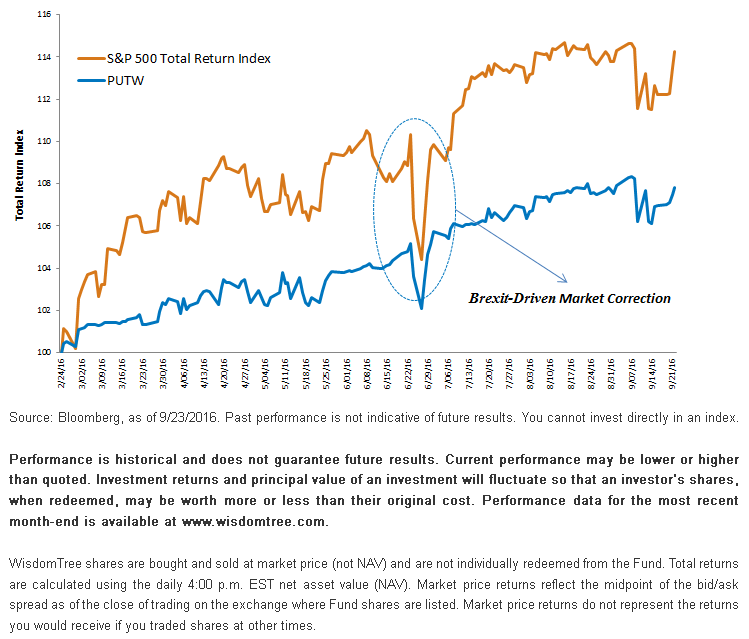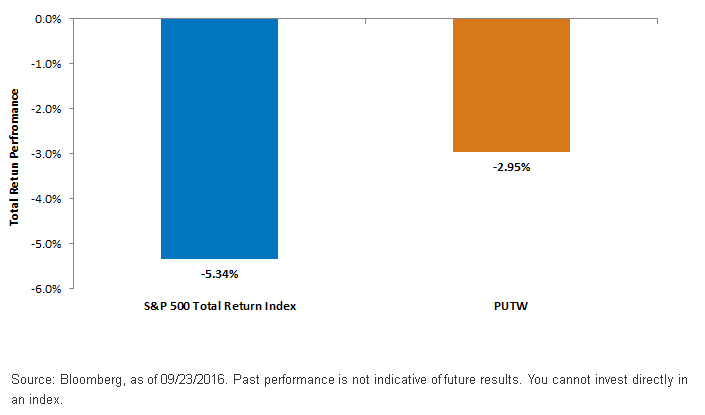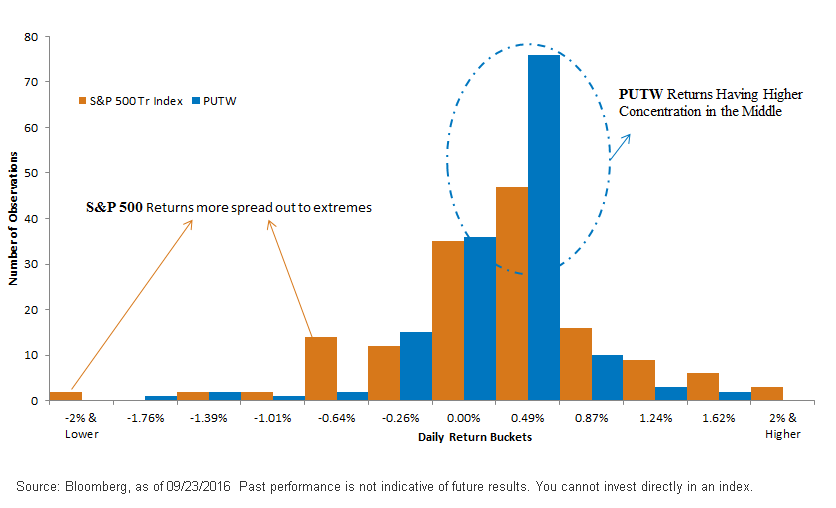Navigating a Bumpy Investment Ride through an Allocation to Put Write


 As volatility came back and equities corrected following Brexit, the S&P 500 lost 5.34% in a few days. Interestingly, PUTW suffered a correction of -2.95%. In other words, there was an outperformance of 239 basis points (bps)—a feature of this strategy that we earlier highlighted and was empirically evident in times when it was most needed!
S&P 500 vs. PUTW
Brexit Volume, 6/23/2016—6/24/2016
As volatility came back and equities corrected following Brexit, the S&P 500 lost 5.34% in a few days. Interestingly, PUTW suffered a correction of -2.95%. In other words, there was an outperformance of 239 basis points (bps)—a feature of this strategy that we earlier highlighted and was empirically evident in times when it was most needed!
S&P 500 vs. PUTW
Brexit Volume, 6/23/2016—6/24/2016
 How about Overall Daily Returns? A Skeptical Risk Manager's Approach
Was the Brexit outperformance merely a coincidence? There is another type of chart that is often used in risk management literature. Risk analysis often involves bucketing returns in various slots and counting the number of observations corresponding to each bucket or slot. If a strategy is less volatile, most of its returns should be concentrated in buckets closer to zero, while a more volatile strategy would see higher number of observations in return buckets that are more extreme or far away from zero. Risk managers call this chart the distribution of returns.
The chart below compares the distribution of returns for the S&P 500 and PUTW. What we see is the following:
• PUTW returns in last six months were more concentrated in the middle (closer to zero in either direction)
• S&P 500 returns had wider variance, with certain days as high as +/-2% returns
• In contrast, PUTW did not have any days with greater than +/-2% return
Less Fat Tails of PUTW, Implying Better Protection for Investors
(2/24/16—9/23/16)
How about Overall Daily Returns? A Skeptical Risk Manager's Approach
Was the Brexit outperformance merely a coincidence? There is another type of chart that is often used in risk management literature. Risk analysis often involves bucketing returns in various slots and counting the number of observations corresponding to each bucket or slot. If a strategy is less volatile, most of its returns should be concentrated in buckets closer to zero, while a more volatile strategy would see higher number of observations in return buckets that are more extreme or far away from zero. Risk managers call this chart the distribution of returns.
The chart below compares the distribution of returns for the S&P 500 and PUTW. What we see is the following:
• PUTW returns in last six months were more concentrated in the middle (closer to zero in either direction)
• S&P 500 returns had wider variance, with certain days as high as +/-2% returns
• In contrast, PUTW did not have any days with greater than +/-2% return
Less Fat Tails of PUTW, Implying Better Protection for Investors
(2/24/16—9/23/16)
 More than anything else, markets hate uncertainty and, looking ahead, both the economic and political outlooks seem uncertain.
Most certainly, the U.S. presidential election is providing uncertainty and the race has been close so far. The Fed’s monetary policy has an element of indecisiveness, more so if the Fed chair, Janet Yellen, continues to internally debate “to be or not to be” a financial dove any longer. Internationally, Britain and the EU are negotiating trade agreements with each other as the two parties formalize their bitter divorce. All of this uncertainty suggests there will be increased volatility in the markets.
Investors should not forget volatility when putting together their asset allocation. Navigating volatility is essential in order to help generate higher risk-adjusted returns. We believe PUTW could be a great complement to an equity allocation. So far, PUTW has shown the ability to lower volatility of traditional equity strategies as highlighted above, and we believe it could help investors’ allocations by cushioning the ride whenever the investment road gets bumpy.
Unless otherwise noted, data source is Bloomberg, as of 9/23/2016.
More than anything else, markets hate uncertainty and, looking ahead, both the economic and political outlooks seem uncertain.
Most certainly, the U.S. presidential election is providing uncertainty and the race has been close so far. The Fed’s monetary policy has an element of indecisiveness, more so if the Fed chair, Janet Yellen, continues to internally debate “to be or not to be” a financial dove any longer. Internationally, Britain and the EU are negotiating trade agreements with each other as the two parties formalize their bitter divorce. All of this uncertainty suggests there will be increased volatility in the markets.
Investors should not forget volatility when putting together their asset allocation. Navigating volatility is essential in order to help generate higher risk-adjusted returns. We believe PUTW could be a great complement to an equity allocation. So far, PUTW has shown the ability to lower volatility of traditional equity strategies as highlighted above, and we believe it could help investors’ allocations by cushioning the ride whenever the investment road gets bumpy.
Unless otherwise noted, data source is Bloomberg, as of 9/23/2016.Important Risks Related to this Article
There are risks associated with investing, including possible loss of principal. The Fund will invest in derivatives, including S&P 500 Index put options (“SPX Puts”). Derivative investments can be volatile, and these investments may be less liquid than securities, and more sensitive to the effects of varied economic conditions. The value of the SPX Puts in which the Fund invests is partly based on the volatility used by market participants to price such options (i.e., implied volatility). The options values are partly based on the volatility used by dealers to price such options, so increases in the implied volatility of such options will cause the value of such options to increase, which will result in a corresponding increase in the liabilities of the Fund and a decrease in the Fund’s NAV. Options may be subject to volatile swings in price influenced by changes in the value of the underlying instrument. The potential return to the Fund is limited to the amount of option premiums it receives; however, the Fund can potentially lose up to the entire strike price of each option it sells. Due to the investment strategy of the Fund, it may make higher capital gain distributions than other ETFs. Please read the Fund’s prospectus for specific details regarding the Fund’s risk profile.
Diversification does not eliminate the risk of experiencing investment losses.
Using an asset allocation strategy does not assure a profit or protect against loss. Investors should consider their investment time frame, risk tolerance level and investment goals.


